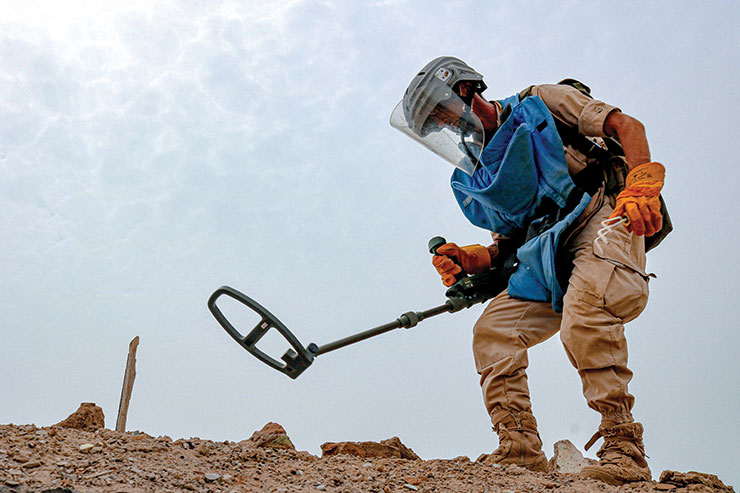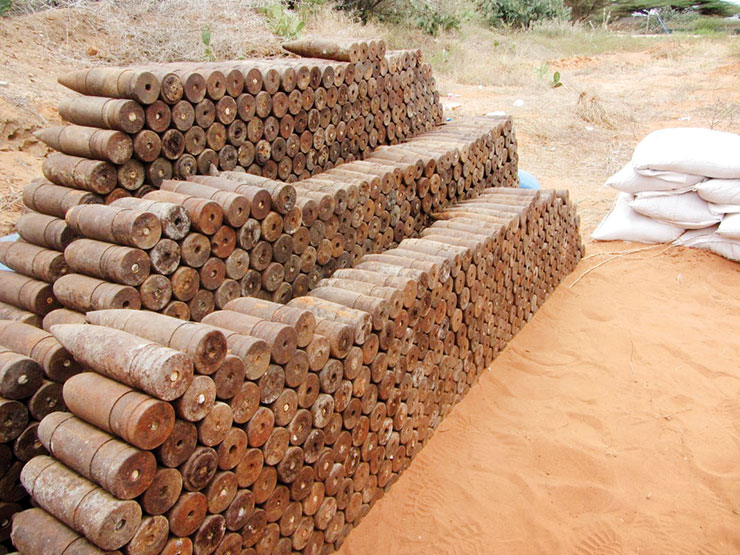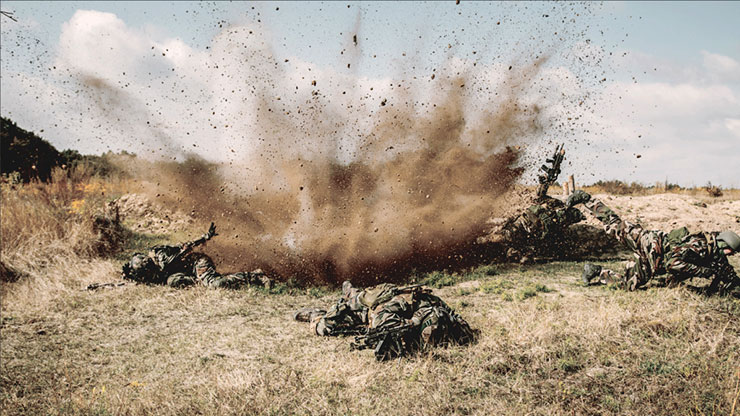
Every year April 4 is observed as the International Day for Mine Awareness as declared by the UN General Assembly on December 8, 2005. The idea behind this is to spread awareness about mines and explosive remnants of war which pose a serious threat to the safety, health and lives of the civilian population.
Explosive Remnants of War (ERW) are explosive devices buried under the ground — landmines, cluster munitions, Unexploded Ordnance (UXO), and other abandoned or discarded explosive devices that pose a threat to human lives – even after the conflict or war is over. ERW pose a substantial danger to civilians and the environment, as they can be triggered accidentally and cause death, injury, or damage to property.
Every hour, people – mostly civilians in so-called peacetime accidentally step on a landmine and die or lose their limbs.
This is because nearly 24 years after the Mine Ban Treaty signed in 1999 to ban the use of landmines – various countries all over the world continue to stockpile, produce, and export antipersonnel mines. Even – nearly 164 countries that signed the global treaty still have more than 50 million antipersonnel mines stockpiles according to the Landmine Monitor report.
The good news is that at least 158 of the countries that signed the treaty, do not stockpile landmines. But the bad news is that countries like Russia (26.5 million), Pakistan (6 million), China (5 million) and India (4-5 million) are among the top three nations which hold the maximum number of landmines in their stock. It is quite surprising that even countries which are signatories of the treaty still keep landmines in their arsenals. Finland is one such example and has more than 16,000 mines in its inventory.
Almost two decades back countries which signed the Mine Ban Treaty committed to never use landmines and also agreed to remove mines buried on their territory. Significantly the campaign to ban the use of landmines got off to a big start when Prince Harry, the Duke of Sussex and his late mother Princess Diana visited an Angolan minefield in 1997 to galvanize global action. This is what ultimately led to the 1999 treaty.
“Somewhere in the world right now, a parent is making the grimmest of choices: to risk cultivating mine-contaminated land or to let their family starve. That is no choice at all. The sooner we are able to clear all the remaining landmines, the less chance there is of innocent lives being lost or changed forever,” Prince Harry was reported to have said.
Since then reportedly about 128 square kilometres of land have been cleared, and 168,000 landmines have been destroyed. But 58 countries including Afghanistan, Bosnia and Herzegovina, Cambodia, Turkey and Yemen continue to have an unbelievably high density/ concentration of landmines per square kilometre.
The year 2017 was the third year in succession to register an exceptionally high number of casualties due to antipersonnel, anti-vehicle and improvised devices. The Landmine Monitor recorded 7,239 casualties – 2,793 people were killed and 4,431 injured.
Afghanistan and Syria topped the list of countries which saw the maximum number of death and disability followed by Ukraine, Iraq, Pakistan, Nigeria, Myanmar, Libya and Yemen. The largest toll was taken by improvised mines (2,716) and the single biggest group of casualties were children (2,452). More than 122,000 mine casualties have been recorded since global tracking began in 1999. Most of these casualties in recent years include civilians (87%).

As of date – 11 countries including China, Cuba, India, Iran, Myanmar, North Korea, Pakistan, Russia, Singapore, South Korea and Vietnam have the capability to produce landmines. Almost 40 countries have stopped producing antipersonnel mines, including Egypt, Israel and Nepal which surprisingly were not a party to the global Mine Ban Treaty. Afghanistan, Colombia, Myanmar, Nigeria and Yemen happen to be among those countries where insurgents have been known to produce landmines.
But despite all precautionary measures, landmine accidents continue to happen. After an active operation is over, the army puts up barbed wire to prominently mark landmine fields. In addition to this, steps are taken to spread awareness among people in the proximate villages who live or work in nearby fields to take adequate precautions and avoid entering the marked areas.
In addition to this, demining operations are carried out to identify, remove or blast landmines over a period of a month. But still, someone somewhere makes a mistake and the unexploded mines get mixed up with firewood for preparing food, fodder to feed cattle or metal scrap presumed to be harmless. Ironically most often the mines dug inside the ground shift their position and explode or detonate even when the slightest pressure is applied to them.
Landmines and other explosive remnants of war are effective deterrents against the enemy, but they continue to kill own army personnel and civilians even after the war is over. Ironically the advancing enemy knows how to avoid landmines, but innocent civilians and children don’t.
As per the SOP (standard operating procedure) – all minefields are laid as per plan and records of all minefields are diligently maintained. Each mine is accounted for and taken out by the same set of troops after the operation is over. But this is something that looks good and happens only on paper. If this was the case – then there would be no casualties of army personnel due to landmine blast.
Use of landmines by Pakistan in the Kargil war
In 1999 during the Kargil War, Pakistan reportedly used landmines and other explosive devices – designed to cause severe injuries or death due to detonation in the presence or proximity of a person or vehicle. The idea behind the extensive use of mines as a defensive weapon by Pakistan was to protect territory and assets from the Indian armed forces. Pakistan is understood to have laid a variety of anti-personnel mines and anti-tank mines along the Line of Control (LoC) in the Kargil sector during the Kargil War.
According to the Landmine Monitor Report 2000, published by the ICBL, Pakistani troops and armed rebel groups used antipersonnel mines in Kargil. The Indian border security and army forces showed the Landmine Monitor researcher the label of the Pakistan Ordnance Factories on crates of antipersonnel mines captured from the armed groups. These landmines caused significant casualties and injuries to both Indian and Pakistani forces. As a result, many soldiers lost their limbs or lives.
Several countries particularly USA, UK, Russia, and Japan publicly criticized Pakistan for using landmines against India in the Kargil war. Even the United Nations condemned the use of landmines which is considered to be a violation of international humanitarian law and can cause severe harm to civilian populations even after the conflict has ended.
The Kargil War is just one of the many occasions when Pakistan has used landmines against India. Besides the Kargil War, Pakistan is known to have planted landmines along the Line of Control (LoC), Siachen Glacier where Pakistani landmines have resulted in several casualties on both sides, as well as the Punjab border.
These incidents have caused numerous casualties among Indian troops as well as civilian populations living along the border and are a clear-cut violation of the Ottawa Convention, which prohibits the use of landmines. Both India and Pakistan are signatories to the Ottawa Convention also known as the Anti-Personnel Mine Ban Convention, which prohibits the use, production, and stockpiling of landmines. This was also a violation of Pakistan’s domestic law and export control procedures.
India’s Landmine Policy
India is not a party to the 1997 Mine Ban Treaty, also known as the Ottawa Treaty which aims to eliminate anti-personnel landmines around the world. However, India is a signatory to the 1997 Ottawa Convention, which is the same treaty but with a different name.
The Ottawa Convention, officially known as the Convention on the Prohibition of the Use, Stockpiling, Production and Transfer of Anti-Personnel Mines was signed in Ottawa, Canada in 1997. It aims to prohibit the use, stockpiling, production, and transfer of anti-personnel landmines.
Though India is not a party to the Mine Ban treaty, it has taken steps towards mine clearance and has contributed to international efforts to ban landmines. India has also renounced the use of APLs and has not produced any since 1997. India has not exported or imported landmines since it signed the 1997 Ottawa Convention and is providing financial and technical assistance for the clearance of landmines and explosive remnants of war in Afghanistan, Sri Lanka, Cambodia, and other countries.
However, India has not signed the 2008 Convention on Cluster Munitions due to its impact on national security and military capabilities.
Pakistan’s Landmine Policy

Pakistan is not a party to the Ottawa Convention. Pakistan’s landmine policy is guided by the National Mine Action Strategy (NMAS), launched in 2015 with the goal of making Pakistan free from the impact of landmines and explosive remnants of war (ERW) by 2023. The NMAS outlines a comprehensive approach to addressing landmines and ERW, including through survey and clearance of contaminated areas, victim assistance, and risk education.
Despite these efforts, landmines and ERW continue to pose a significant threat to civilians in Pakistan, particularly in areas affected by conflict and displacement.
Violation of humanitarian and international laws on landmines by Pakistan
There have been allegations of Pakistan violating humanitarian and international laws on landmines. For example, it has been reported that Pakistan has used anti-personnel landmines in its conflict with India in the disputed region of Jammu and Kashmir, which is prohibited under the 1997 Ottawa Convention.
There have also been reports of Pakistan laying landmines along its border with Afghanistan, which has resulted in civilian casualties and hindered the delivery of humanitarian aid. The use of landmines in populated areas is prohibited under international humanitarian law, as it poses a significant risk to civilians.
In addition, there have been concerns about the proliferation of landmines in Pakistan, including the production and transfer of anti-personnel landmines. But Pakistan is not a party to the Ottawa Convention and hence is not bound to honour its provisions. This is all the more reason why the international community or the world’s moral policemen should intervene and make Pakistan pay for its sins and adhere to international humanitarian and human rights laws, which include protecting civilians from the harmful effects of landmines and other explosive devices.
–The writer is a seasoned media professional with over three decades of experience in print, electronic, and web media. He is presently Editor of Taazakhabar News. The views expressed are of the writer and do not necessarily reflect the views of Raksha Anirveda















